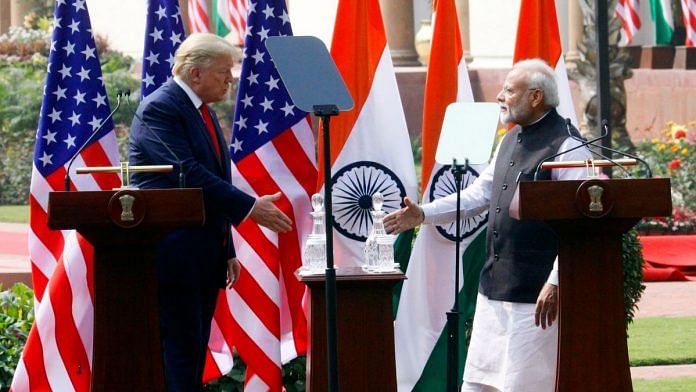New Delhi: India and the US may not have signed the elusive limited trade deal during the visit of US President Donald Trump last month, but Washington was able to ask New Delhi to participate in the Blue Dot Network (BDN), an initiative under the quadrilateral mechanism that seeks to build and finance quality infrastructure projects.
According to the joint statement — Vision and Principles for India-US Comprehensive Global Strategic Partnership — issued after the US President Donald Trump’s bilateral meeting with Prime Minister Narendra Modi on 25 February, both leaders have “expressed interest” in the BDN initiative.
“To guarantee that the infrastructure of the future is built in a safe, transparent, and accountable manner, the United States is working with a range of partners, including Australia and Japan, to create the Blue Dot Network, a major initiative to ensure countries around the world have access to private sector-led, sustainable, and trustworthy options for high-quality infrastructure development, and that’s what’s happening,” Trump had said after he met Modi in New Delhi.
ThePrint deciphers BDN and its implications for India.
Also read: CPEC – China’s most ambitious project in Pakistan has become a corridor to nowhere
What is Blue Dot Network?
The concept of the Blue Dot Network was officially launched on 4 November 2019 at the Indo-Pacific Business Forum in Bangkok, Thailand. It will be led by the US along with Japan and Australia — the three countries, along with India, form the Quadrilateral grouping.
According to the US-India joint statement, the Blue Dot Network will “be a multi-stakeholder initiative that will bring governments, the private sector, and civil society together to promote high-quality trusted standards for global infrastructure development”.
Under it, infrastructure projects within the Indian Ocean Region will be certified in keeping with globally-recognised standards that uphold principles of transparency and financial viability.
“By proposing a common standard of project excellence, the Blue Dot Network will attract private capital to infrastructure projects in developing and emerging economies,” stated a note by the State Department.
The infrastructure projects will have to follow the G-20 principles for Quality Infrastructure Investment, aimed at sustainable lending and borrowing, the G7 Charlevoix Commitment on Innovative Financing for Development, and the Equator Principles, which mandate financial institutions to assess and manage environmental and social risks in a given projects.
Projects that aim to be certified under the Blue Dot Network will have to give an undertaking that they adhere to these principles. The undertaking will then be scrutinised.
India remains one of the US’ sought-after choices for the initiative since the country refused to join the China-led Belt & Road Initiative (BRI), Xi Jinping’s ambitious platform for trade among Asia, Europe and Africa that counts infrastructure development in member nations — often at unsustainable loans — as a key pillar.
But it does not exclude those who are part of the Belt and Road project also.
According to a November 2019 report — A Free and Open Indo-Pacific: Advancing a Shared Vision — by the US Department of State, the US International Development Finance Corporation will be at the forefront of the initiative with $60 billion in development financing to attract more private sector investment into emerging markets.
How does it help to be a Blue Dot Network partner?
A country that joins the Blue Dot Network as a partner will boost its project capability efforts. Further, if the infrastructure development projects of that particular country obtain a Blue Dot certification, they will be seen as adhering to the highest level of global standards.
Access to private and public financing institutions will help mitigate financing risks, acting as an impetus for developing countries like India to smoothly undertake development projects domestically as well as internationally.
“A developing country that agrees to implement BDN standards signifies that the government values high-quality infrastructure that benefit local communities. The Blue Dot Network will provide countries with clear project standards. Projects, companies, and governments that meet or uphold the standards can build public confidence in their commitment to good practices,” said the State Department note.
Also read: Counter to BRI? Why India-US’ thrust on Blue Dot Network will make China see red




It is in India’s best interest to join BDN. China considers Japan and India as natural enemies. Any amount of appeasement to China will be useless. India should take them head on and join US and other countries because we are natural friends. We have to forget the past and join hands with the US